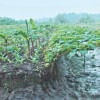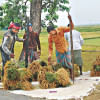Farmland turns WASTELAND
Selim Uddin, 50, had been a farmer all his life like his father and his father before him. Until a few years ago, he earned his living by farming on a small piece of land and fishing in canals in and around his South Madrasa union in Chittagong's Hathazari upazila.
But massive industrial pollution has changed all that not only for him, but for hundreds of other farmers as well.
Over the last few years, industrial waste has turned huge swaths of arable land into wasteland, forcing Selim and others to turn to other less secure professions such as day labourers.
Official data is not available, but local public representatives and surveyors estimate that farming on some 3,000 acres of land in three unions of the upazila have been affected by the pollution. Now instead of seedlings only shrubs grow on those land.
The factory waste coming from Bayezid area has also polluted at least seven canals that run through these unions -- Shikarpur, Burishor and South Madrasa.
Only a few years ago, farmers would use the waters for irrigation. But that's a story of the past.
“The canals and the land have been polluted in front of our eyes. We have been protesting and urging the authorities to stop the pollution for many years now. But no one listened,” said a visibly frustrated Selim, who now works as a mason.
The three unions have a population of about 1 lakh, and a large number of them have been affected one way or the other. Some lost their livelihoods while others, especially children, have been contracting various skin diseases, according to local representatives.
FACTORIES, CDA TO BLAME
Industrial pollution has long been a problem in Hathazari.
At least 22 factories, including cotton mills, washing and dyeing factories, power plants, steel mills and textile mills in Bayezid area discharge about 11.74 lakh liters of liquid waste into the Bamonsahi canal every day, according to the Department of Environment.
“In the past, the waste released by the factories in Bayezid area used to fall into the Karnaphuli river through this canal,” said Abu Bakkar Siddiki, chairman of Shikarpur union.
But things took a turn for the worse in 2009 after the Chittagong Development Authority (CDA) launched a mega housing project -- Anannya Residential Area -- on the south part of the union.
First the CDA authorities started to dump construction materials here and there, eventually blocking the Bamonsahi canal, he said.
So to save their residential area from pollution, the CDA dug a “master drain” in 2012, linking Bamonsahi canal with Kuyaish canal that flows through Shikarpur union. The drain is 800 feet long and 20 feet wide.
Soon, pollution spread to other areas since Kuyaish canal is connected to six other canals -- Katakhali, Khondokiya, Bathuya, Krisnokhali, Bamonshahi and Madari.
Farmers used to use waters from these canals for irrigation, but as they are all polluted now people cannot use them, said MA Majid, chairman of South Madrasa union, another badly hit area.
Last year, the Halda River Research Institute did a study to look into the extent of the pollution. It found each of the eight canals heavily polluted with industrial and domestic waste.
The study detected caustic soda, sulphur and heavy metal in the waters, all signs of industrial pollution, said Prof Dr Manzoorul Kibria, director of the Institute.
NO IMPACT ASSESSMENT
The 1,500-acre Lalachondra Beel under Sikarpur union is the worst affected. The Beel is locally known for growing Ropa Aman, Boro and Ropa Aus as well as vegetables such as cauliflower, cabbage, eggplant and bitter gourd.
In 2011, about 4,000 tonnes of rice were grown in the Beel, said Bijan Kanti Sikdar, sub-assistant agricultural officer of Hathazari upazila.
The production gradually came down since the pollution started to appear in 2012, he added, although he could not give any figure.
“To tell you the truth we did not carry out any survey on the impact or the extent of the pollution. But we will start collecting information from our field officers,” he told The Daily Star.
Sheikh Abdullah Wahed, agriculture officer of Hathazari upazila, also confirmed that a significant portion of the arable land in the area stopped growing anything due to the pollution. He too could not give any data.
Abu Bakkar, chairman of Shikarpur union, said they formed many human chains, held rallies and wrote to the Department of Environment, the Chittagong Development Authority and even former Environment and Forest Minister Anisul Islam Mahmud, who is from Hathazari.
“But nothing worked,” he said.
Only last week, the authorities began excavating the Bamonshahi canal.
THE DENIAL
Contacted, Azadur Rahman Mollik, director of DoE, Chittagong, said they wrote thrice to the CDA to close the master drain that is carrying industrial waste deep into Hathazari upazila, polluting canals and arable land.
The CDA did not carry out environmental impact assessment (EIA) nor did it take environmental clearance for the residential project, which is mandatory, he added.
“We also instructed them to excavate the Bamonsahi canal so the waste can fall into the Karnaphuli and at least save the Halda river. As they did not pay heed to our instructions, they must shoulder the responsibility for the pollution,” he said.
Asked why his department was failing to stop the pollution by the industries, he said they were trying their best.
According to him, all the factories had environmental clearance.
During an inspection in February last year, the DoE found that all the factories in the area had functional Effluent Treatment Plants. He blamed untreated domestic waste for the pollution.
CDA Chairman Abdus Salam shrugged off his responsibility.
“Filling up the drain is not the solution. The solution is to stop the pollution at its source. Why is not the environment department taking any steps to stop the pollution by the factories?” he said.

 For all latest news, follow The Daily Star's Google News channel.
For all latest news, follow The Daily Star's Google News channel. 








Comments